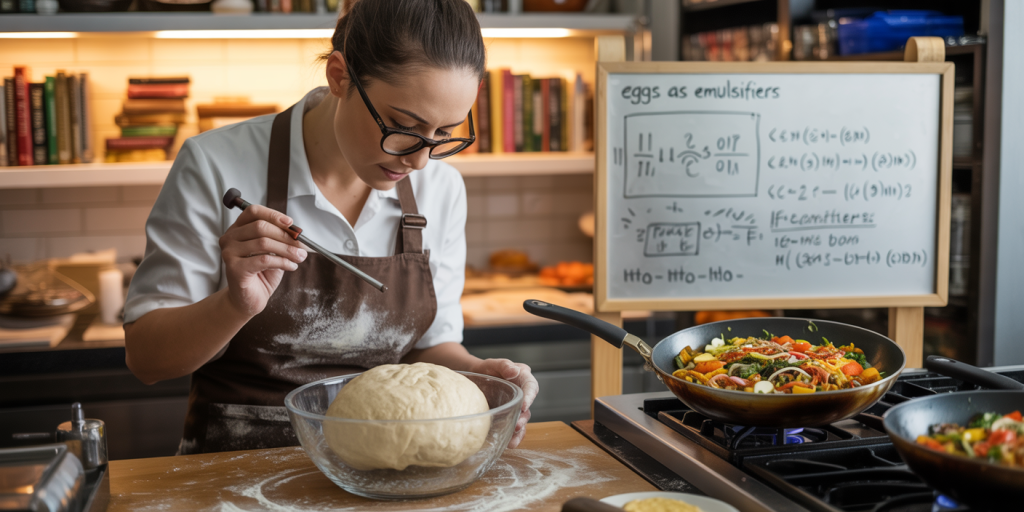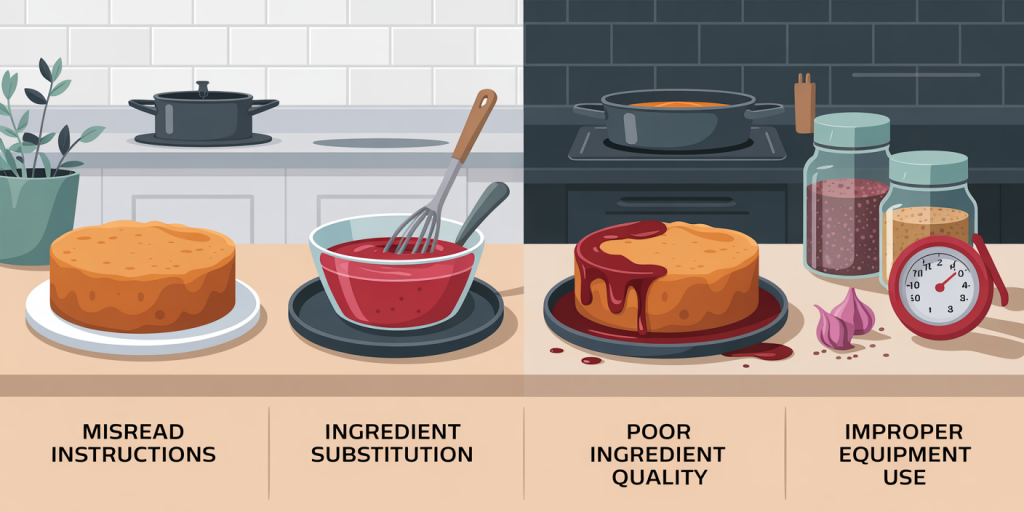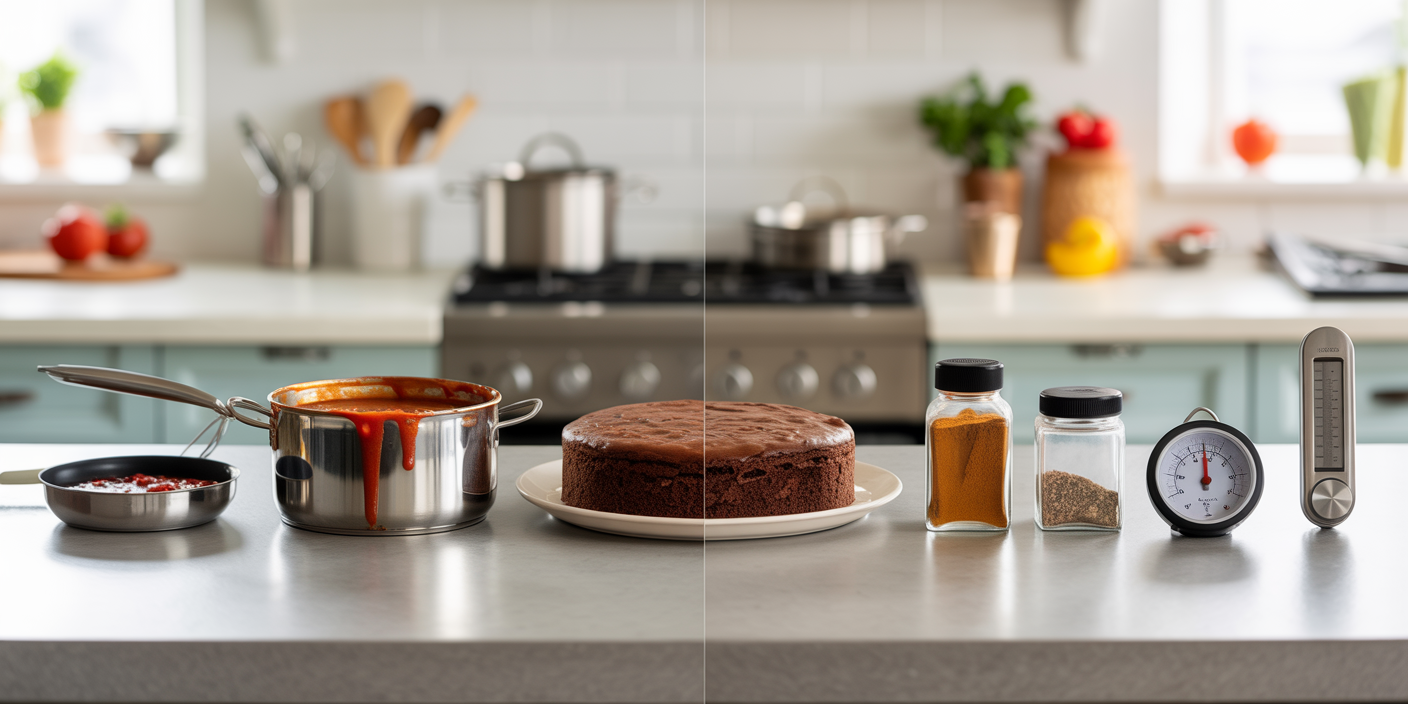Cooking is as much an art as it is a science. Whether experimenting with new recipes or following tried-and-true directions, the journey from kitchen counter to plate can lead to spectacular successes or unexpected disasters. But what truly distinguishes a recipe fail from a win? The answer often lies behind the scenes—in the choices made during preparation, the ingredients selected, and the techniques applied. This article delves into the dynamics of cooking success and failure, offering practical insights and real-world examples to illuminate the cooking process beyond the final dish.
The Science and Art of Recipe Success
Cooking blends creativity with scientific principles, and understanding both is crucial to achieving recipe wins instead of fails. For instance, baking is a precise science governed by exact temperatures, ingredient ratios, and chemical reactions. Even the slightest alteration in baking powder quantity can cause a cake to rise too much or not at all, indicating a fail. Conversely, cooking a savory stew allows more flexibility, embracing the art form through seasoning adjustments and cooking times tailored to taste.
A practical example is the difference between making bread and a stir-fry. Bread requires exact measurements, proofing times, and oven temperatures to develop gluten structure and proper crumb. According to a 2022 survey conducted by the Flour Bakers Guild, about 70% of amateur bakers reported multiple bread failures before mastering a basic loaf. On the other hand, a stir-fry’s success hinges more on timely heat application and ingredient freshness, offering room for improvisation and immediate corrections.

Understanding the science behind each recipe enhances the likelihood of success. Knowing why eggs act as emulsifiers or how acid affects protein denaturation can turn a potential fail into a culinary triumph.
Common Causes of Recipe Failure
Recipe fails often stem from simple but critical missteps during preparation, ingredient handling, or technique execution. One of the most common issues is misreading or misinterpreting recipe instructions. Ambiguities such as “cook until done” or “a pinch of salt” can be confusing to beginners, leading to undercooked meals or over-seasoned dishes.
In another frequent scenario, ingredient substitution without understanding the role of each component can cause failures. For example, swapping baking soda for baking powder without adjusting the amount can skew the pH balance, leading to flat or bitter cakes. Similarly, using low-quality or stale ingredients results in diminished flavor profiles and texture degradation, as corroborated by a recent study on ingredient quality and taste by the Culinary Institute of America (CIA, 2023).
Moreover, inappropriate equipment or temperature control is a silent culprit behind many fails. Cooking at too high a heat can burn delicate sauces, while insufficient heat leaves meats undercooked and unsafe. Kitchen tools, such as dull knives or faulty ovens, can hinder preparation and alter expected outcomes.
The below table summarizes some typical causes of recipe failure with practical examples:
| Cause | Example | Effect | Solution |
|---|---|---|---|
| Misinterpreting Instructions | Cooking pasta “al dente” too long | Mushy texture | Clarify instructions; timing |
| Ingredient Substitution | Using baking soda instead of baking powder | Bitter flavor, flat rise | Research ingredient roles |
| Poor Ingredient Quality | Using expired spices | Bland or off tastes | Use fresh, quality ingredients |
| Improper Equipment Use | Oven temperature set too low | Undercooked dish | Use oven thermometer, calibrate |
This practical exercise of anticipating and addressing common pitfalls can prevent many kitchen failures.

Success Stories: Learning from Culinary Wins
Success in cooking often arises through attention to detail, patience, and sometimes, creative adaptation. Consider the story of chef Dominique Ansel, whose invention of the Cronut involved months of trial and error. The perfect layering of croissant dough fried like a donut was a major win that turned him into a trendsetter, demonstrating how iterative experimentation leads to breakthroughs.
Home cooks frequently share their wins too. A notable example involves a home baker struggling with sourdough bread for months. After analyzing water quality, fermentation time, and flour brands, she found success by switching to filtered water and using organic whole wheat flour. Her win was not accidental but the result of systematic troubleshooting and knowledge accumulation.
Moreover, integrating modern technology has aided recipe wins. Smart thermometers and kitchen scales, alongside recipe apps offering step-by-step guidance, improve precision. According to the National Restaurant Association’s survey in 2023, 62% of home cooks credit digital tools for enhancing their cooking outcomes.

For instance, a comparative case study between cooking traditional roast chicken with and without a smart thermometer highlights temperature control importance:
| Method | Outcome | Pros | Cons |
|---|---|---|---|
| Without Thermometer | Sometimes over or undercooked | Simplicity, no extra tools | Inconsistent results |
| With Smart Thermometer | Consistently moist and tender | Precision, confidence | Initial investment cost |
These success stories emphasize that knowledge, technology, and perseverance converge to transform experimentation into culinary triumph.
The Role of Recipe Customization and Adaptation
Following a recipe verbatim may not always lead to guaranteed success. Adapting recipes to suit local ingredients, dietary needs, or personal preferences often enhances the cooking experience and result. However, this requires understanding recipe fundamentals to avoid unintentional fails.
Take the example of gluten-free baking. Standard recipes rely on gluten’s elasticity to trap air and create texture. Successful adaptation involves substituting with xanthan gum or other binding agents, requiring knowledge of chemistry and texture balance. According to a market report by GlobalData (2024), the gluten-free baking segment has grown by 14% annually, driven largely by successful recipe adaptation efforts.
Similarly, seasoning adjustments based on cultural taste preferences highlight the importance of flexible recipe approaches. While a traditional Indian curry may call for specific spice blends, substituting with locally available herbs in different countries can maintain flavor harmony without compromising authenticity.
A comparative table detailing traditional vs adapted recipe elements illustrates this idea:
| Recipe Element | Traditional Approach | Adapted Approach | Impact |
|---|---|---|---|
| Flour Type | All-purpose wheat flour | Gluten-free flour blends | Texture adaptation, allergy-friendly |
| Spice Mix | Garam masala | Local herb blends | Flavor balance but culturally relevant |
| Cooking Medium | Ghee or clarified butter | Olive oil or vegetable oil | Changed aroma and richness |
| Cooking Time/Heat | Moderate slow cooking | Higher heat for faster cooking | Faster preparation, flavor differences |
Recipe customization empowers cooks to turn potential fails into wins through informed modifications.
Psychological Factors Behind Recipe Outcome
The human element plays a vital role in cooking success or failure. Stress, impatience, and multitasking in the kitchen can cause overlooked details, rushed steps, or emotional frustration leading to cooking disasters. In contrast, mindful cooking enhances focus, attention to ingredient details, and reduces errors.
Research published in the Journal of Culinary Science & Technology (2023) found that cooks who practiced mindful cooking techniques were 30% more likely to report positive outcomes in complex recipe preparation. Mindful practices included carefully reading instructions, prepping ingredients in advance (mise en place), and tasting at stages rather than solely at the end.
In groups or families, collaborative effort often promotes success. Sharing roles, soliciting feedback, and learning from each other reduces the chances of failure. Conversely, cooking alone without adequate experience intensifies the risk of overlooking steps or not recognizing mistakes early.
For example, professional kitchens emphasize teamwork and clear communication to ensure consistency. Reducing cognitive load also prevents errors during high-pressure service periods. Home cooks embracing similar strategies see measurable improvements.
Future Perspectives in Cooking Success
Emerging trends and technological advances promise to reshape how recipe fails and wins are defined in coming years. Artificial intelligence (AI) is playing an increasing role in personalized recipe recommendations that account for dietary restrictions, ingredient availability, and skill levels. Platforms like IBM’s Chef Watson and other AI chefs analyze vast recipe databases and generate bespoke cooking plans minimizing the risk of failure.
Additionally, kitchen appliances integrated with AI and IoT (Internet of Things) provide real-time feedback on cooking progress. Smart ovens automatically adjust temperatures and cooking times based on sensor data, enabling home cooks to achieve professional results with lesser errors.
Education innovations are also critical. Interactive cooking apps with augmented reality (AR) can guide users step-by-step visually, significantly reducing common misunderstandings of recipe instructions. Future data predicts that by 2030, over 75% of home cooks will use some form of technology-assisted cooking.
However, the human creative spirit will remain central to recipe wins. The fusion of scientific support, technological tools, and personal adaptation will democratize excellent cooking, turning more fails into wins worldwide.
—
Cooking is a journey marked with trial, learning, and occasional success or failure. Understanding the science and art behind recipes, common pitfalls, real-world success stories, customization, psychological influences, and future innovations sheds light on how different factors converge behind the scenes. Whether a beginner or expert, embracing these insights creates a more informed and joyful kitchen experience where most recipes can turn into wins, fueling passion and confidence in cooking endeavors.

Deixe um comentário